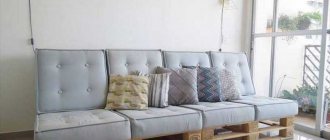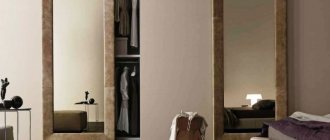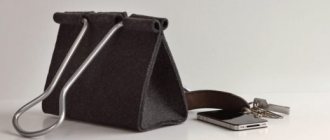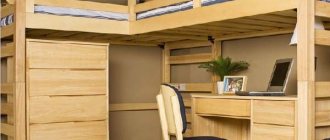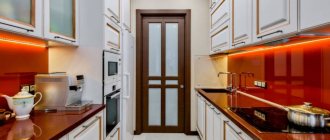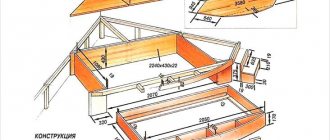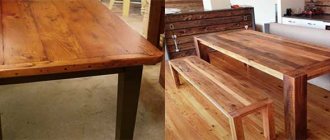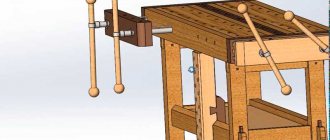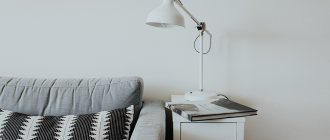Many parents always have difficulties when arranging a children's room. Especially often they cannot choose the right furniture; it is important that it is of high quality and comfortable. The main thing is that furniture elements must correspond to the tastes of children and please them. Of course, furniture stores have a lot of furniture for children, but often parents want to create for their child not just a nursery, but his own corner. Therefore, you can try to make these products. This process is quite labor-intensive, but do-it-yourself children's furniture will be of much higher quality and better than that offered by many manufacturers.
Materials for children's furniture
The basis for furniture must be chosen very carefully, based on the quality and safety of the materials. Cheap materials are of low quality, and it is better not to skimp on your child’s health by choosing something safe and environmentally friendly. Incorrectly selected low-cost materials can release harmful substances, so they must be eliminated.
During the game, children can run and knock over everything in their path, which is why the furniture in the children's room should be safe, without sharp corners and potentially dangerous elements in the form of decorative elements and other parts.
If you are interested in children's furniture for playing with your own hands, then it is best to opt for solid wood. Avoid chipboard, as this material emits harmful substances called formaldehyde.
Materials
The furniture departments offer a wide range of products for the children's room, made from different materials. Each has its own pros and cons that need to be taken into account when choosing. The main requirements for them are: environmental safety and high quality.
| Material | Description | pros | Minuses |
| Tree | The frame is made from solid wood | Environmental safety, absence of emitted harmful substances. Natural color, pleasant woody smell | Sensitivity to humidity and temperature changes, which leads to swelling or cracking. High price. Soft woods are susceptible to dents and scratches if not handled carefully. |
| MDF | The frame is made of compressed wood boards covered with plastic, veneer or synthetic film | High strength. Environmentally friendly material, as it does not contain carcinogens and synthetic resins. Various designs of furniture products, attractive appearance | The surface may be damaged during play, causing the veneer or film to peel off. High price |
| Chipboard | Furniture is made from particle board, the surface of which is covered with paints, veneer or film | Low cost. After treatment with special compounds, the material acquires fire resistance and durability properties. | Toxic material (except class E1) |
| Plywood | The frame is made of plywood sheets, the surface is laminated or veneered | Furniture made from high-quality plywood is strong and durable. Variety of design solutions. Low cost | Low-quality material contains formaldehyde and synthetic resins, which lead to allergies. Strength characteristics are lower than those of wood and MDF. The surface is highly susceptible to deterioration |
| Plastic | The main types of plastic structures: tables, chairs, chests of drawers, doll furniture | Light weight products, compactness. Interesting design and various colors. Low cost. Easy care | Low-quality plastic is toxic. Quite fragile material |
| Cardboard | To make furniture you need cardboard with a corrugated insert. Suitable for making a children's house with your own hands | Environmentally friendly. Quite durable furniture if properly processed. Light in weight. Does not require large financial investments; Unusual design | Does not tolerate humidity and temperature changes |
| Foam rubber | The main type of products made from it is upholstered furniture | A light weight. Mobility of the structure. Low cost | Poor quality material quickly loses strength characteristics |
Raw materials should not emit harmful substances that can harm children.
Thick burlap or cotton fabric is used as a covering material for furniture. They cover springs and other frame elements, and also sew back covers. Beautiful, practical materials are used for upholstery: jacquard, tapestry, chenille, velor, flock and others. These fabrics are durable and easy to care for, and are not subject to rapid wear.
Master class on creating pockets for a locker in kindergarten
You may also need various compositions: varnishes, paints, emulsions that protect the surface from environmental influences. When assembling furniture, the following fasteners are required: screws, nuts, screws, self-tapping screws, eccentric couplers, dowels and corners. Drawings and assembly diagrams are easy to find on thematic resources.
Tree
MDF Chipboard Plywood Plastic
Cardboard
Foam rubber
Velours
Chenille Tapestry
Jacquard Flock
How to choose material?
The safest materials for a child's room are presented in the following list.
- Wood massif
- Fine particle board
- Premium plywood
- Fabrics and fillers must be natural, confirmed by quality certificates
Do not use paints and varnishes with a strong odor, as they are very toxic. It is better to choose a fabric that is easy to clean from stains and is as wear-resistant as possible.
Photo ideas for decorating a children's room
Design in the style of “princess room” Cartoon characters - no competition
Ubiquitous Kitty
The nautical theme is popular among boys, and with a two-story bed...
More serious young people prefer calm tones
An interesting option - a play area above the bathroom. Older children - different interiors in the nursery.
Modern design trends have not bypassed children's
On the side, the bed has been converted into a storage system. A practical option for a children's room in the attic - there are many interesting solutions
When the child is alone, but you want a bunk bed...
Rational use of every centimeter of space is possible... Boat-shaped beds... This design of a children's room is suitable for both boys and girls...despite the fact that the predominant color is blue. Sunny weather is always...
For young cosmonauts
Requirements for children's furniture
Any DIY children's play furniture must meet certain requirements.
- Furniture should consist of natural materials.
- The use of nails is prohibited; bolts and screws may be used.
- There should be no sharp corners or too small elements.
- The edges of the furniture should be well finished with a protective edge.
- The fittings must be safe.
- It is necessary to give preference to strength and conciseness.
- Instead of an abundance of decorative elements, it is best to use patterns on furniture.
Types of designs
The children's room should be divided into three functional areas: a sleeping area, a play area, a creative area and a learning area. Based on this, different types of furniture are used:
- Soft designs. They are installed for sleeping and relaxing, giving the interior a special coziness. To save space in the room, you can choose sofas with additional accessories: shelves, drawers, cabinets. The functionality of such furniture also lies in the fact that at night it is used as a place to sleep, and during the day - for games or reading.
- Play furniture. Often the space in the room is equipped with such items as a do-it-yourself children's kitchen, a puppet theater, a hair salon with a dressing table and various shelves for combs, a hospital complex with medical supplies. It can also be furniture that imitates cars, trains, carriages. Sports complexes, consisting of horizontal bars, swings, and slides, will develop the physical abilities of children.
- Cabinet furniture. It consists of closed structures: pencil cases, cabinets, wardrobes, beds with drawers for bed linen, chests of drawers, tables (computer or bedside). Such DIY products for a children's room should be functional and spacious.
Ready-made sets, consisting of several items, allow you to decorate the room in the same style
Soft
Gaming Cabinet
A child’s room can be equipped with the following do-it-yourself furniture set:
- a bed or sofa for sleeping and relaxing;
- desk, study chair;
- a wardrobe for books, writing instruments and a wardrobe for clothes;
- shelves for various things;
- special furniture for toys, for example, a children's kitchen set is in demand;
- sports corner.
School furniture standards, basic GOST requirements and selection criteria
Soft ottomans will ideally complement the interior of the room and add coziness. They are safe, and you can easily sew them with your own hands using patterns. Frame products are also easy to manufacture. Wardrobes, beds, bedside tables, shelves - you can do all this yourself.
Children's furniture: manufacturing features
Making furniture yourself is an extremely exciting and interesting process that captivates you from the first minutes. With the necessary tools and a few basic skills, you can make amazing furniture that will certainly serve your child for a long time and reliably.
The most important thing is to calculate the amount of material and purchase it in the right quantity; of course, do not forget about fittings and fasteners. You must first draw an exact diagram of the furniture so that you don’t make a mistake when marking and cutting the material.
Types of furniture for a children's room
Various photos of homemade children's furniture will help you make your choice. You can show them to your child so that he can independently choose the furniture he would like to see in his room.
What can you put in the nursery?
— Bed house. Very popular furniture that is loved by children; it is very comfortable to sleep in. Such a bed can be made from pallets, then sanded and painted with paint or varnish, which can be used to paint children's furniture.
— Playing corner – a triangular seat with a wall has a simple design. This material can be made from timber, pallets or MDF boards.
— A children's table and chair are a place where the baby will draw or write, as well as engage in various creative activities.
— Racks and shelves are the simplest elements of furniture that even a beginner can make. Of course, even in this case it is necessary to adhere to the previously prepared scheme.
Manufacturing of children's play furniture
Items intended to entertain a child can be made using simplified sketches. For this, inexpensive materials are used - chipboard, plywood, thick cardboard. The originality of this design depends on the child’s passion. Popular play furniture:
- kitchens;
- hospitals;
- cars;
- ships;
- rockets;
- aircraft.
Light tones are used in natural combinations.
Some models can be combined to save room space. For example, make a crib in the shape of a racing car.
The base of the products should be made from natural materials.
It is important to make the environment in the baby’s room attractive and cheerful, since the child is here all the time.
Furniture for a baby must be safe, so everything - from material to fastenings - is selected in accordance with this requirement. It is better to cut off all protruding corners and make them streamlined.
In their opinion, children's furniture must certainly be original and appeal to kids.
Children's furniture will acquire an aesthetic appearance if you make some adjustments to its decoration.
Making a bed
The first and most important piece of advice is to not skimp on materials. A child's bed must meet general standards. The right mattress, which is purchased in a specialized store, is of great importance. All elements of the bed are manufactured separately, after which they are assembled.
The following elements are used for the bed:
- Fine boards (MDF), the thickness of which is at least two centimeters;
- All components must be glued with a special glue intended for wood;
- For strength, metal corners and screws are used;
The bed should correspond to the height of the child and be comfortable for him.
Manufacturing instructions
How to make children's furniture quickly and correctly? This question interests many parents who plan to equip their children's room with homemade products. But if you have to do this for the first time, then many professionals recommend that you carefully familiarize yourself with the manufacturing process - look at photos, videos on the Internet. You can try to start by making something simple, for example, a small chest of drawers or a shelving unit. This will allow you to become more closely acquainted with the process of manufacturing furniture elements for children.
Various videos with detailed manufacturing processes help a lot. In the video you can see assembly diagrams, decoupage and furniture design. Children's kitchens made from old furniture are in high demand. In this case, you can not only save on materials, but also restore old furniture that has not been used for a long period.
An obligatory step in manufacturing is determining the types of furniture needed. Children usually require a bed and a children's table. In the future, you can make a cabinet or purchase ready-made products. A good option would be to make your own frameless furniture. These types of products are much easier to make, but at the same time they will be the most suitable for children.
Bed
So how do you make furniture for children with your own hands? First you need to make a bed. This product is of great importance for the full growth and development of the child.
If the bed is made correctly in accordance with the requirements and standards, then it will have a beneficial effect on posture and overall well-being. To begin with, it is better to make a drawing with dimensions. A schematic drawing will facilitate the process of making a bed. Each element must be manufactured separately. In the future, the components will simply need to be connected to each other.
Features of manufacturing a furniture element for sleeping:
- MDF sheets are often used to make beds. The thickness of each sheet must be at least 2 cm;
- movable elements should be made from a base with a fine structure. For curb strips, the most suitable thickness would be 1.2 cm;
- the constituent elements are glued with glue with a strong base. For fastening, you can use strong connections - screws or metal corners;
- if the product needs to be fixed on the wall, then it is better to use dowels made of plastic material or screws.
The furniture element for the sleeping area must be manufactured in accordance with the necessary requirements. An assembly drawing, of course, will make the whole process easier, but in this case you will also need detailed instructions:
- the main plank made of natural wood is fixed to the area of the upper border;
- the end panel must be secured at the base of the wall partition; its fastening should not be very tight;
- from the attachment point of the end panel it is required to screw MDF squares with a large thickness;
- the end of the base should move away from the wall surface a small distance, which is equal to the thickness of the MDF squares. The walls of the stock body will be mounted into the resulting openings;
- As the end wall is completely mounted to the corner area, a special partition is attached to it in a perpendicular relation to fence off the compartment. In the production of these constituent elements, corners made of a metal base can be used;
- At the point where the dividing wall ends, the side panel must be secured. When making this part, be sure to maintain a small distance from the wall. The housing wall will be placed in this area;
- after the end of the dividing strip, its continuation should be the next base.
When installing children's furniture yourself at home, be sure to take into account the fact that it must fit the children's height. If you are decoupaging old furniture, it is important to remember that, first of all, the furniture must be comfortable and fit the child’s size.
The main bar is fixed
End panel installation
We fasten the sidewalls
Children's table
A children's table is a necessary item in a child's room. Children often engage in various developmental activities - drawing, reading, modeling, cutting. And to implement them, you need a table.
Of course, if the house already has an old table, then you can update it, adjust it to the height of the children and perform beautiful decoupage. But you can make it yourself.
The table execution process is carried out as follows:
- first of all, the legs are cut out according to the height of the future structure;
- End mills are used to attach the legs to the frame components with the load-bearing structure. When installing the legs, you need to mark the locations for the grooves and align the paired components. A hole is drilled in the marked area, but it should not be through;
- The leg blanks must be clamped one by one in a clamp. Next, the wood is selected with an end mill as carefully as possible until a smooth groove with the required size is obtained;
- using a hacksaw and a knife, the ends of the parts of the load-bearing frame are adjusted, tenons are created, which will then fit firmly into the grooves of the legs;
- all component parts are coated with glue and assembled into a single whole;
- at the end, after the entire structure has dried, the tabletop is inserted into special grooves in the legs, and it is fixed with glue.
The legs are cut out, we attach them to the frame, we correct the ends of the parts
Coat with glue
We mount the countertop
Tools: required set
Any production process requires certain tools. To make furniture you need to have the following tools:
- Screwdriver
- Screwdriver Set
- Ratchet with different heads
- Drill and hammer drill
- Electric jigsaw
- Grinding machine
- Fraser
- Pliers, hammer, mallet
- Tape measure, marker, awl, stationery knife
For some furniture, it is not necessary to use all of the above tools. For example, children's furniture made of cardboard does not require electrical tools.
If you still need power tools, you can rent them, since purchasing everything you need will not be cheap.
How to make a children's ottoman?
This is the simplest furniture that does not have a frame. Even a beginner can handle making an ottoman. As a cover, it is best to use raincoat fabric, or any other dense fabric that can be cleaned. This is comfortable and functional upholstered furniture for the nursery, which will definitely be useful to the baby.
You can choose any color of the fabric - neutral or bright, depending on the interests of the child. You can use foam balls as filler, which are perfect for both an ottoman and a bean bag chair.
It is necessary to leave several holes on the top of the fabric so that air can circulate inside. To make the ottoman even softer, you can sew an additional cape from soft fabric, you can use velvet, velor or fur.
The best workshops on making children's furniture
At home, you can make different designs that will be appropriate in your child’s room. The most common models are not at all difficult to implement. There are a lot of examples in open sources on how to make children's furniture with your own hands.
Frameless pouf
The simplest furniture models that you can make with your own hands are frameless poufs. To make it you will need fabric, thread, a sewing machine and filler. The cover can be made of dense material, for example, raincoat fabric. Foam balls are used as filler.
Sequencing:
- The cover is cut out in the desired shape: round, elongated, square.
- The edges are neatly stitched.
- The side that is sewn last is filled with filler.
To prevent the air from stagnating inside, it is recommended to leave small holes in the case for ventilation. However, you need to make sure that they are of a size through which the contents of the pouf will not spill out. Do-it-yourself frameless furniture will become softer if you additionally sew a cape onto it.
Selecting filler Cutting parts for the case Sewing parts
Filling the bag
The chair is ready
Simple bed
The bed can also be made at home from old furniture. You will need fastenings: corners and screws, as well as non-toxic glue and varnish that covers the product. Tools needed: screwdriver, screwdriver, wood saw, sandpaper.
Making the bed:
- A drawing is created with the required dimensions.
- The bed parts are cut out from it.
- All elements are processed with sandpaper and varnished.
- The parts are connected using corners and self-tapping screws.
- A mattress is placed on the bottom.
The legs of the bed are made of bars, and the bottom is made of slats that allow air to circulate. The backs are cut out in the form of rectangles, as well as the bottom, which should be sized according to the height of the child.
Creating a drawing Cutting parts Grinding
Painting
Assembly
Installation and decoration
Plywood playhouse
Such a “home” will be interesting for any child to play with. For a children's house, it is necessary to determine the height of the floors: the dolls with which the baby plays must fit into it at full height. For the work you will need the following materials and tools: plywood, drill, jigsaw, nails, hammer, wood glue, paint or varnish, paint brushes, pencil, ruler.
Sequencing:
- According to the drawing, parts are cut out of plywood using a jigsaw.
- The edges of the sheets are sanded.
- You can make window openings in the blanks for the “walls”.
- After this, the parts are assembled using glue and secured with nails.
You can install LED light bulbs in the house, and also make furniture for dolls with your own hands.
Drawing selection
Cutting and marking parts
Sanding elements Painting
Assembly and decoration
Modular sofa made of cardboard
Despite the fact that cardboard is a paper material, furniture made from it is quite durable and functional. The sofa can be made from large boxes, for example, from household appliances. For work you need: PVA glue, furniture stapler, stationery knife, ruler, upholstery fabric, foam rubber.
Types and features of furniture for a children's room, important selection criteria
Stages of work:
- A square-shaped sample is drawn on a piece of Whatman paper. It must match the child's height.
- A backrest, also equal in height, is attached to it - a vertical rectangle.
- Using this template, about fifty identical blanks are cut out of cardboard. Strips of the same material are used as gaskets, which are glued together in pairs. The required number of parts is 100 pieces, corresponding in height to the sofa and equal in width to the back, 200 strips - equal to the height of the seat.
- Gaskets are glued to the first blank: long - to the back, short - in the seat area to the middle and to the edge.
- This is how all the prepared elements are glued together. The resulting sofa frame should dry.
- Prepared Whatman paper and foam rubber are glued to the product, after which the workpiece is dried again.
- At the last stage, a pre-sewn cover is put on the sofa and secured with a stapler.
You can prepare several such modules of children’s furniture with your own hands and rearrange them during operation according to the child’s wishes.
Cut and glue cardboard pieces
Stick foam rubber
Pull the covers
Chair made of thick foam rubber
To make a chair with your own hands for a child's room, thick foam rubber is also suitable. Furniture made from this material will be light and comfortable. To make it you will need foam rubber, PVA glue, and a knife.
Sequencing:
- Blanks are cut out in the shape of the letter “L” - you will need 5 of them.
- They stick together.
- The top of the chair is covered with soft fabric.
To prevent the joints from being felt, you can additionally use felt or batting, which are glued to the module.
Cut out parts from foam rubber
Glue elements
Put on the cover
